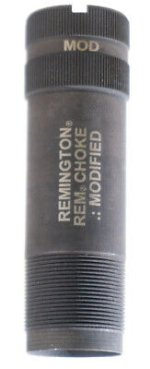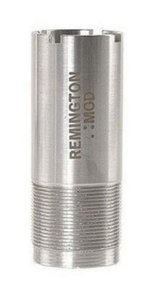You are using an out of date browser. It may not display this or other websites correctly.
You should upgrade or use an alternative browser.
You should upgrade or use an alternative browser.
Extended choke benefits ?
- Thread starter FatCatsDad
- Start date
Tool less changes , more of an issue with target guns . But its nice just to grab the end of the tube instead of looking for your wrench in your range bag.
In theory the longer length allows a different cross section to offer a longer transition in the choke constriction or whatever geometry the manufacture is looking for. It also allows for porting and or marking a visible indication of the chokes constriction .
In theory the longer length allows a different cross section to offer a longer transition in the choke constriction or whatever geometry the manufacture is looking for. It also allows for porting and or marking a visible indication of the chokes constriction .
George on YouTube at the new hunters guide has done some great testing with chokes
As mentioned if they are designed right they offer a longer parallel portion to improve patterns.
Not all chokes are created the same.
I do like the extension for tooless changes and it's easy on the range to keep them tight
They must be matched to the barrel diameter. The bigger the original diameter the more choke it needs to make the pattern. The smaller the bore the less constriction.
As mentioned if they are designed right they offer a longer parallel portion to improve patterns.
Not all chokes are created the same.
I do like the extension for tooless changes and it's easy on the range to keep them tight
They must be matched to the barrel diameter. The bigger the original diameter the more choke it needs to make the pattern. The smaller the bore the less constriction.
How do you know it will line up on the top?
FatCatsDad
CGN Ultra frequent flyer
It has a locking ringHow do you know it will line up on the top?
I don’t know if I believe it, but some claim that the extra half inch length moderates the choke. I doubt it.
It is nice to have something to hold onto while changing it. That’s better for people who leave them hand tight and want a quick tool-less change, though I personally don’t.
It makes it easy to visually identify the constriction marked on it.
I don’t know if it really makes any functional difference in the ones I’ve used.
It is nice to have something to hold onto while changing it. That’s better for people who leave them hand tight and want a quick tool-less change, though I personally don’t.
It makes it easy to visually identify the constriction marked on it.
I don’t know if it really makes any functional difference in the ones I’ve used.
That makes sense. Couldn't tell from the photoIt has a locking ring
Ocd is a mental illness you shouldn't feel ashamed of your collection lol. It's also good justification to your significant other.I personally don’t like them lol!!View attachment 920568
My beretta extended chokes have a denser and more even pattern than the flush mounts. However those factory flush mounts throw a better denser pattern than my Carlson extended chokes. Fact is I wasted my money of the Carlson extended chokes. I've used other makers extended chokes that provided nicer denser patterns. Muller chokes were some of the best I've used.
That's not to say you can't have great patterns with flush chokes. My Teague flush chokes pattern great as well
Unfortunately it's one of those things you need to try it with the loads you intend on using. Gotta pay to play sorta thing
That's not to say you can't have great patterns with flush chokes. My Teague flush chokes pattern great as well
Unfortunately it's one of those things you need to try it with the loads you intend on using. Gotta pay to play sorta thing
Falconflyer
CGN Ultra frequent flyer
In theory, a longer transition to the smaller diameter will give more time for the pellets to relocate and deform less which in turn should reduce flyer pellets and produce better patterns. Some manufacturers build in a parallel section maybe 1/2 to 3/4 inches long at the muzzle end which allows the shot column to stabilize at the smaller diameter before exiting.
Does all of this extended choke tube technology produce better patterns than flush chokes? Maybe and maybe not, I think a lot depends on the ammo used. Obviously lead shot with higher antimony content will deform less than lead shot with less antimony and long forcing cones contribute greatly to less pellet deformation, possibly more so than the choke tube itself. On older guns the forcing cones can be 1/2 to 3/4 inches long but newer guns can be 4 inches or in some cases such as the Dt11 much longer than that. I’m a big believer in long forcing cones, maybe not the entire length of the barrel per say but certainly several inches.
There’s been innovations in choke tubes that are note worthy and Muller Featherweight’s fall into that category. They are made of aluminum with a ceramic coating and in my experience produce some of the most consistently dense patterns that I’ve seen. They’re much slower than some other tubes to build up wad plastic in the throat area.
Briley and Teague are also some of the best tubes I’ve used.
Extended tubes are handy for those sporting clays shooters who change tubes often but ported choke tubes don’t do anything except make noise and annoy your shooting buddies.
Does all of this extended choke tube technology produce better patterns than flush chokes? Maybe and maybe not, I think a lot depends on the ammo used. Obviously lead shot with higher antimony content will deform less than lead shot with less antimony and long forcing cones contribute greatly to less pellet deformation, possibly more so than the choke tube itself. On older guns the forcing cones can be 1/2 to 3/4 inches long but newer guns can be 4 inches or in some cases such as the Dt11 much longer than that. I’m a big believer in long forcing cones, maybe not the entire length of the barrel per say but certainly several inches.
There’s been innovations in choke tubes that are note worthy and Muller Featherweight’s fall into that category. They are made of aluminum with a ceramic coating and in my experience produce some of the most consistently dense patterns that I’ve seen. They’re much slower than some other tubes to build up wad plastic in the throat area.
Briley and Teague are also some of the best tubes I’ve used.
Extended tubes are handy for those sporting clays shooters who change tubes often but ported choke tubes don’t do anything except make noise and annoy your shooting buddies.
Falconflyer
CGN Ultra frequent flyer
Constriction is constriction in its relativity to barrel diameter.George on YouTube at the new hunters guide has done some great testing with chokes
As mentioned if they are designed right they offer a longer parallel portion to improve patterns.
Not all chokes are created the same.
I do like the extension for tooless changes and it's easy on the range to keep them tight
They must be matched to the barrel diameter. The bigger the original diameter the more choke it needs to make the pattern. The smaller the bore the less constriction.
If a 12 guage with a bore diameter of .721 inches needs 35 thousands constriction to make full choke then a 12 guage with a barrel diameter of .745 will also need 35 thousands constriction to make full choke. So the gun with the .721 barrel will need a choke of .686 and the barrel with the .745 will need a choke of .710 diameter.
Keep in mind that this is all academic though and different ammo will pattern differently in different guns. Two guns using the same constriction can produce different patterns.
I meant by the bore size as in gauge. A 410 needs alot less constriction to go thru the typical patter size range than a 12 bore does.
35 thousandth of an inch has more effect on a smaller bore than it does on a larger bore such as a 10ga. Maybe I'm not explaining it as well as I could
As for the 12ga with various bore diameters some makers mark the choke by constriction where others just go with the typical cylinder mod and full ect. Other go with close range mid range and long range. Often these chokes produce a pattern that is outside the pellet count for the desired choke. That's why patterning is so important. Ammo used changes patterns thru various chokes as well.
All in all I think most ppl over think it but there are some categories where it does matter. Turkey hunting and buck shot are the 2 I focus on most
For skeet anything from cylinder thru mod doesn't change my scores but it certainly changes the range buckshot is effective.
35 thousandth of an inch has more effect on a smaller bore than it does on a larger bore such as a 10ga. Maybe I'm not explaining it as well as I could
As for the 12ga with various bore diameters some makers mark the choke by constriction where others just go with the typical cylinder mod and full ect. Other go with close range mid range and long range. Often these chokes produce a pattern that is outside the pellet count for the desired choke. That's why patterning is so important. Ammo used changes patterns thru various chokes as well.
All in all I think most ppl over think it but there are some categories where it does matter. Turkey hunting and buck shot are the 2 I focus on most
For skeet anything from cylinder thru mod doesn't change my scores but it certainly changes the range buckshot is effective.
in theory if the parts that choke down are longer the effect would be more gradual and/or stronger. The longer the choke the more accurate to the intended pattern. I can picture that being a big factor in some shot sizes and velocities but not in others.
I know from one friend that for high volume shooting it can help dissipate heat a bit faster
I know from one friend that for high volume shooting it can help dissipate heat a bit faster
Falconflyer
CGN Ultra frequent flyer
Fair enough Bryben, we’re on the same page and I agree, as you go down in guage then less constriction is needed to gain the same effect.
Falconflyer
CGN Ultra frequent flyer
That’s an interesting theory, can you explain how that works?in theory if the parts that choke down are longer the effect would be more gradual and/or stronger. The longer the choke the more accurate to the intended pattern. I can picture that being a big factor in some shot sizes and velocities but not in others.
I know from one friend that for high volume shooting it can help dissipate heat a bit faster










































































